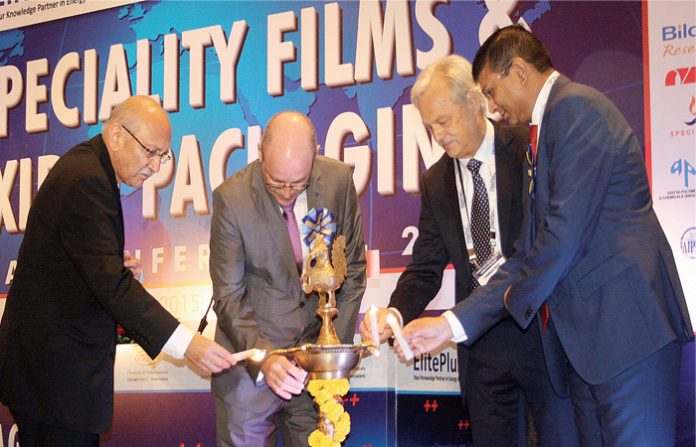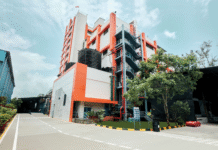The two-day Speciality Films and Flexible Packaging Global Conference 2015, organized by Elite Plus on 15 and 16 September, was full-to-capacity, as expected. More than 700 attendees representing 340 organizations from 25 countries across the globe were there in full attendance. Dozens of brand owners, including HUL, Kimberly Clark, Marico, Perfetti Van Melle, and decision makers from the converting and manufacturing industry were among those present.
They focussed on the opportunities available for the packaging industry with regards to barrier packaging, innovative polymers and processing machinery. With many individual states proposing selective ban on plastic waste, sustainability has become a key issue in the field of flexible packaging. To counter this, the industry experts discussed methods such as the conversion of waste into crude oil, and converting polymers into biodegradable polymers.
Bobst Italy – Shaft-less and shaft-fed cylinders

Discussing the pros and cons of shaft-less and shaft-fed cylinders, Giovanni Caprioglio, sales and marketing director, Bobst Italy said, “Shafted cylinder offers the maximum speed of 600 metres a minute and is a better fit for long runs and inline laminations.” He feels the issue of cylinder damage is a concern while executing the shafting operation.
“With a shaft-less machine, one can have a wider range of cylinder dimension permissible with in the range of press at the maximum speed of 500metre a minute with an offline preparation line. The demand for shaft-less machines is gradually increasing, it was around47% in the year 2014 to 2015,” added Caprioglio. With a shaftless machine, one can have a wider range of cylinder dimension permissible within the range of press at the maximum speed of 500 metre a minute with offline preparation line. Shaft-less based machine demands are gradually increasing, around 47% in the year 2014 to 2015.
He also shared information regarding gravure from shaftless and the factors that caused improvements, such as continuous reduction of job length, and fast changeover that leads to an increase in the number of cylinders that can be dismounted in a day with less manpower. Caprioglio also discussed the twintrolley for Rotomec 4003gravurepress and the
new shaft-less press model RS5002 – both specially designed for the Asian market – to help users achieve optimum production levels, expand their capacity and succeed in the markets. The session concluded with a video presentation on the twin trolley use on gravure presses.
Cosmo’s speciality packaging films
Speaking about the company’s innovative solutions in speciality packaging films, Pankaj Poddar, chief executive officer, Cosmo Films, said, “Aroma-based transparent biaxially oriented polypropylene (BOPP) films can improve shelf-life by nine months. Such films retain crispness and odour of food products.” Concerning high oxygen and aroma barrier films (HOA) and the metallized films, he said, “HOA films have a low water vapour transmission rate (WVTR) and is suitable for dried fruits and ready-to-eat meals besides biscuits and chocolates. Metallized barrier films possess properties of high moisture vapour barrier and can be used as a sandwich layer between the laminates. In many cases it can even replace metallized PET which can be used for shampoo sachets, dry milk powder and powdered drink sachets.”
BOPP is commonly found in candy wrappers, chips’ packaging, vitamin multi-packs and more. BOPP has more flexibility than polyester and can be used in various processes such
as metallizing, packaging, stationery products, labelling, and more. For good barrier resistance with seal strength, Cosmo Films has developed a metallized film with less oxygen transmission rate (OTR) and WVTR. This can be used for packaging biscuits, bakery and snacks (about 300 to 400 grams in weight). “Ease of opening is an important parameter in packaging that is overlooked in India. Here, BOPP provides a laminate structure for better barrier and shelf-life for snack and confectionery products,” concluded Poddar.
DuPont Packaging and Industrial Polymers
Roger Kant, marketing director, Asia Pacific – DuPont Packaging and Industrial Polymers, who has a broad experience in packaging and industrial polymers, shed light on the global
food security (GFS) and the role of packaging. Kant said, “According to Food and Agricultural Organization, around 50% of the fresh farm-produced food and vegetable ends up as a waste. We need to focus on the food value chain from one end to another.”
During the first stage of processing, technical limitations prevent efficient processing and result in loss of food. Industrial processes such as packaging, marketing and transport complications can contribute to the wastage.
The Bemis Company package is made up of two individually sealed compartments, DuPont Selar PA and DuPont Bynel in a resealable package. This transformational package largely
improves consumer experience by allowing the userto easily peel and reseal the package with fingertip pressure. “India ranks 68th in the Global Food Security Index (GFSI), good or bad, I leave it for you to decide,” he concluded.
Michelman’s surface coating technology

At the conference, Bill Magee, group director, printing and packaging – Michelman, spoke about the surface coatings available for flexible packaging. According to him, “Coating technologies are used for seal-ability. Print receptivity coating is water-resistant and can be applied to paper, metal foil or metallized surfaces, and various substrates that bond well to various inks on printed films. It has a broad sealing temperature range along with an excellent hot tack for vertical form fill used in combination with the right primer or ink, varnish for protection. The surface characteristics of the substrate can be modified for preserving, processing and packaging purposes.”
Other solutions offered by Michelman are extrusion coating primers, primer grades and heat seal coatings. Extrusion coating primers render packaging films and papers more receptive to extruded PE and PP films. Primer grades are optimized for applications ranging from very demanding retort packages to more basic end uses. Heat seal coatings are water-based, often primer-less, and balance low initiation temperatures with high ultimate bond strength. Magee also discussed the advantages of water-based over solvent-based coatings including the absence of volatile organic compounds, which is free from fire hazards in storage areas; easy to-recycle; has equipment compatibility with in-line film, coating lines and converting operations.
QuadTech talks about color quality and control

Discussing the changing market trends and expectations of the brand owners that can influence the printers, Stephan Doppel hammer, market manager, packaging at QuadTech, said, “We want to create an awareness among the brand owners and converters about the importance of color use in a production unit, besides the evaluation of print defects. With the color values of the target sample, the information can be fed to QuadTech solution that will provide consistent colors in repeated jobs. It can ease the burden of the printers by allowing them to avoid archiving of color shades and pulling it out at the time of reprinting. QuadTech solution also helps the printer to store the ink recipe that can provide better quality with less amount of makeready time and raw material wastage, enhancing the production rate.”
He highlighted the fact that brand owners or end-customers are now thinking critically about color and ink. “So, an Indian printer has to stress on color quality and control. Both these needs can be efficiently met with our solution and we are seeing a rising demand from Indian printers for such innovative solutions. Even our installations are getting amazing responses from around the world. I know, it is too early to say anything but I can surely say that the seeds of growth have been planted,” concluded Doppel hammer.
Wells Plastics’ oxo-biodegradable technology
Speaking on the plastic litter and the ways to deal with it, John James, export manager of Wells Plastics, explained, “The broad use of flexible polymer packaging for many food and non-food products creates litter due to careless disposal. This cannot only harm humans, animals and marine life, but also can last for many years in the environment. The absence of an effective gathering and plastic waste management system has collectively made plastic packaging a major issue in India and rest of the world. Therefore, tackling the issue should be important for the FMCG companies, government bodies, media organizations and NGOs.”
Wells Plastics offers a new grade of Reverte – oxo-biodegradable technology – for PET films. The on-cost to the finished structure and the brand owner is relatively small. Since most of the flexible plastic packaging in India has a layer of PET or METPET film, this new development is expected to revolutionize the fight against flexible plastic packaging litter in India. Oxo-biodegradables have no physical impact on the processing of the polymer. The flexible film retains all the properties during its lifetime. If such a product is found in the environment, the degradation process rapidly commences.











